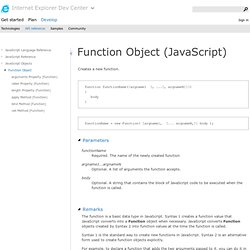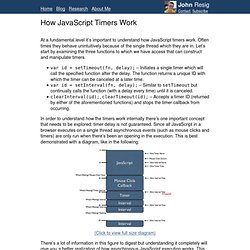

Function Object (JavaScript) Function functionName([argname1 [, ...[, argnameN]]]) { body } functionName = new Function( [argname1, [... argnameN,]] body ); functionName Required.

The name of the newly created function argname1...argnameN Optional. Body Optional. The function is a basic data type in JavaScript. Syntax 1 is the standard way to create new functions in JavaScript. For example, to declare a function that adds the two arguments passed to it, you can do it in one of two ways: function add(x, y) { return(x + y); } var add = function(x, y) { return(x+y); } In either case, you call the function with a line of code similar to the following:
Prototypes. Objects and Inheritance. Chapter 17.

Objects and Inheritance There are several layers to object-oriented programming (OOP) in JavaScript: Each new layer only depends on prior ones, enabling you to learn JavaScript OOP incrementally. Layers 1 and 2 form a simple core that you can refer back to whenever you are getting confused by the more complicated layers 3 and 4. Roughly, all objects in JavaScript are maps (dictionaries) from strings to values. There are three kinds of properties: Properties (or named data properties) Normal properties in an object—that is, mappings from string keys to values. Accessors (or named accessor properties) Special methods whose invocations look like reading or writing properties. Internal properties Exist only in the ECMAScript language specification. JavaScript’s object literals allow you to directly create plain objects (direct instances of Object). Use this in methods to refer to the current object (also called the receiver of a method invocation).
> jane.unknownProperty undefined Tip. How JavaScript Timers Work. At a fundamental level it’s important to understand how JavaScript timers work.

Often times they behave unintuitively because of the single thread which they are in. Let’s start by examining the three functions to which we have access that can construct and manipulate timers. var id = setTimeout(fn, delay); – Initiates a single timer which will call the specified function after the delay. 16 JavaScript Concepts. (Essential JavaScript Concepts for Modern JavaScript Development ) If you plan to work as JavaScript Professional, you must know some JavaScript concepts and JavaScript-related web-development technologies, particularly as a modern JavaScript developer.

If you know the 16 concepts enumerated below, you have the skill necessary to build world-class modern JavaScript web applications, and you are set for the near future—0 to 3 years. I will expound on each of these sixteen concepts, and I am hopeful all of us will have become better JavaScript programmers by the time we get through all of them. I have completed most of the 16 concepts with just a few more to go, so keep reading and learning. And sign up for the newsletter to get the latest updates. I trust you have learned JavaScript properly or you already know JavaScript enough to build a simple JavaScript-only web application.
MDN JavaScript Guide. JavaScript (JS) is a lightweight, interpreted, or just-in-time compiled programming language with first-class functions. While it is most well-known as the scripting language for Web pages, many non-browser environments also use it, such as Node.js, Apache CouchDB and Adobe Acrobat. JavaScript is a prototype-based, multi-paradigm, dynamic language, supporting object-oriented, imperative, and declarative (e.g. functional programming) styles. Read more about JavaScript. This section is dedicated to the JavaScript language itself, and not the parts that are specific to Web pages or other host environments. For information about APIs specific to Web pages, please see Web APIs and DOM.